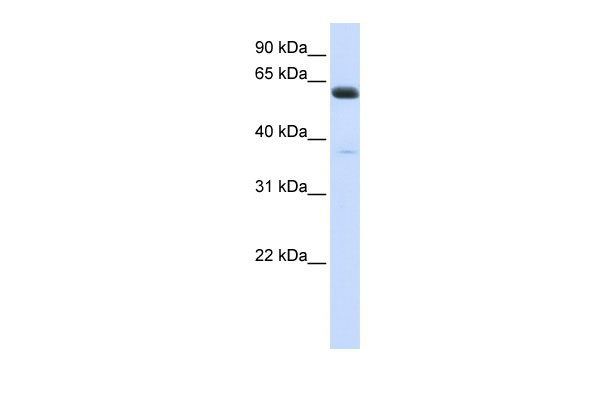ALG6 antibody - N-terminal region
Rabbit Polyclonal Antibody
- SPECIFICATION
- CITATIONS
- PROTOCOLS
- BACKGROUND

Application
| WB |
|---|---|
| Primary Accession | Q9Y672 |
| Other Accession | NM_013339, NP_037471 |
| Reactivity | Human, Mouse, Rat, Rabbit, Zebrafish, Pig, Horse, Bovine, Dog |
| Predicted | Human, Mouse, Rat, Zebrafish, Pig, Chicken, Horse, Bovine, Dog |
| Host | Rabbit |
| Clonality | Polyclonal |
| Calculated MW | 58kDa |
| Gene ID | 29929 |
|---|---|
| Alias Symbol | CDG1C |
| Other Names | Dolichyl pyrophosphate Man9GlcNAc2 alpha-1, 3-glucosyltransferase, 2.4.1.267, Asparagine-linked glycosylation protein 6 homolog, Dol-P-Glc:Man(9)GlcNAc(2)-PP-Dol alpha-1, 3-glucosyltransferase, Dolichyl-P-Glc:Man9GlcNAc2-PP-dolichyl glucosyltransferase, ALG6 |
| Format | Liquid. Purified antibody supplied in 1x PBS buffer with 0.09% (w/v) sodium azide and 2% sucrose. |
| Reconstitution & Storage | Add 50 ul of distilled water. Final anti-ALG6 antibody concentration is 1 mg/ml in PBS buffer with 2% sucrose. For longer periods of storage, store at 20°C. Avoid repeat freeze-thaw cycles. |
| Precautions | ALG6 antibody - N-terminal region is for research use only and not for use in diagnostic or therapeutic procedures. |
| Name | ALG6 (HGNC:23157) |
|---|---|
| Function | Dolichyl pyrophosphate Man9GlcNAc2 alpha-1,3- glucosyltransferase that operates in the biosynthetic pathway of dolichol-linked oligosaccharides, the glycan precursors employed in protein asparagine (N)-glycosylation. The assembly of dolichol-linked oligosaccharides begins on the cytosolic side of the endoplasmic reticulum membrane and finishes in its lumen. The sequential addition of sugars to dolichol pyrophosphate produces dolichol-linked oligosaccharides containing fourteen sugars, including two GlcNAcs, nine mannoses and three glucoses. Once assembled, the oligosaccharide is transferred from the lipid to nascent proteins by oligosaccharyltransferases. In the lumen of the endoplasmic reticulum, adds the first glucose residue from dolichyl phosphate glucose (Dol-P- Glc) onto the lipid-linked oligosaccharide intermediate Man(9)GlcNAc(2)-PP-Dol to produce Glc(1)Man(9)GlcNAc(2)-PP-Dol. Glc(1)Man(9)GlcNAc(2)-PP-Dol is a substrate for ALG8, the following enzyme in the biosynthetic pathway. |
| Cellular Location | Endoplasmic reticulum membrane; Multi-pass membrane protein |

Thousands of laboratories across the world have published research that depended on the performance of antibodies from Abcepta to advance their research. Check out links to articles that cite our products in major peer-reviewed journals, organized by research category.
info@abcepta.com, and receive a free "I Love Antibodies" mug.
Provided below are standard protocols that you may find useful for product applications.
References
Gregory,S.G.,(2006)Nature441(7091),315-321ReconstitutionandStorage:Forshorttermuse,storeat2-8Cupto1week.Forlongtermstorage,storeat-20Cinsmallaliquotstopreventfreeze-thawcycles.
If you have used an Abcepta product and would like to share how it has performed, please click on the "Submit Review" button and provide the requested information. Our staff will examine and post your review and contact you if needed.
If you have any additional inquiries please email technical services at tech@abcepta.com.













 Foundational characteristics of cancer include proliferation, angiogenesis, migration, evasion of apoptosis, and cellular immortality. Find key markers for these cellular processes and antibodies to detect them.
Foundational characteristics of cancer include proliferation, angiogenesis, migration, evasion of apoptosis, and cellular immortality. Find key markers for these cellular processes and antibodies to detect them. The SUMOplot™ Analysis Program predicts and scores sumoylation sites in your protein. SUMOylation is a post-translational modification involved in various cellular processes, such as nuclear-cytosolic transport, transcriptional regulation, apoptosis, protein stability, response to stress, and progression through the cell cycle.
The SUMOplot™ Analysis Program predicts and scores sumoylation sites in your protein. SUMOylation is a post-translational modification involved in various cellular processes, such as nuclear-cytosolic transport, transcriptional regulation, apoptosis, protein stability, response to stress, and progression through the cell cycle. The Autophagy Receptor Motif Plotter predicts and scores autophagy receptor binding sites in your protein. Identifying proteins connected to this pathway is critical to understanding the role of autophagy in physiological as well as pathological processes such as development, differentiation, neurodegenerative diseases, stress, infection, and cancer.
The Autophagy Receptor Motif Plotter predicts and scores autophagy receptor binding sites in your protein. Identifying proteins connected to this pathway is critical to understanding the role of autophagy in physiological as well as pathological processes such as development, differentiation, neurodegenerative diseases, stress, infection, and cancer.


